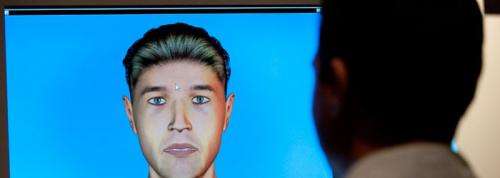UA-developed avatar is helping to screen new arrivals at Bucharest airport

(Phys.org) —Border police in Romania are testing a technology developed at the University of Arizona that uses a virtual border agent to question international travelers and flag those that give off suspicious vibes.
The screening system – called AVATAR, which is short for Automated Virtual Agent for Truth Assessments in Real-Time – has been installed in a kiosk at Henri Coandă International Airport in Bucharest. The avatar conducts brief interviews with travelers right after they disembark from flights into Bucharest, monitoring respondents' body language and verbal replies to identify irregular behavior that warrants further investigation.
Speaking to travelers in their native languages, the avatar asks country-specific visa questions while measuring behavior, physiology and verbal responses. After the interview, European Union Agency border guards are provided with interview summaries, which display on their tablets.
It's the first European field test of the system, which is being developed by The National Center for Border Security and Immigration, or BORDERS. The Department of Homeland Security Center of Excellence comprised 18 premier institutions and is based at the UA. AVATAR also has been tested at the U.S.-Mexico border.
The screening technology could one day be used at land ports of entry, airports, detention centers and visa processing offices. Possible applications include a number of screening scenarios, such as trusted traveler application programs, personnel follow-up investigations, visa application reviews and other situations where truth assessment is a key concern.
The field test in Romania is sponsored and coordinated by Frontex, the European Union border-control agency, which has been working with BORDERS since 2010.
"The Romanian border police have been invaluable by providing access to their facilities, officers and cadets," said Elyse Golob, executive director of BORDERS. "We appreciate their willingness and foresight in allowing us to test the passport security of the future at their airport."
Border security experts from Romania and European Union Agency member states – including those specializing in fraudulent document detection and anti-trafficking – also are involved in the field test, as well as students from the Alexandru Ioan Cuza Police Academy and researchers and professors from European universities.
Results from the field test will be used to shape how the AVATAR system could be used in the future.
"We are thrilled to get the AVATAR into a real-world testing scenario and to see how people interact with the technology in an airport setting," said Jay Nunamaker, BORDERS director and principal investigator for AVATAR.
Provided by University of Arizona


















